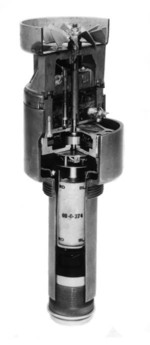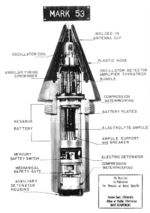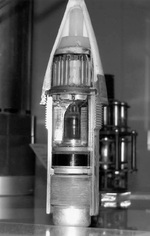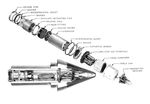VT Radio Proximity Munitions Fuze
| Country of Origin | United States |
| Type | Munitions Fuze |
Contributor: David Stubblebine
ww2dbaseFour secret projects were pivotal to Allied victory in World War II; the atomic bomb, radar, codebreaking, and the radio proximity fuze.The basic function of a fuze is to detonate an explosive charge at the intended moment. Timed fuzes are as old as explosives themselves but the mechanisms have taken many forms. For projected ordnance such as artillery shells, rockets, torpedoes, aerial bombs, and mortars, the simplest fuzes are contact fuzes but munitions experts had always looked for ways to detonate the charges just before impact to maximize their effect. Various timing schemes were explored but none had satisfactory results; something more sophisticated was needed. In the anti-aircraft role in particular, a fuze that caused the shell to explode when the fuze itself sensed being close to an airborne target, a proximity fuze, was especially desirable. The British Royal Navy and the United States Navy were both particularly interested in acquiring an anti-aircraft proximity fuze. Germany began developing such a fuze in the 1930s but a workable version never went into production. British military researchers led by the eminent Samuel C. Curran created reasonably effective radar-based proximity fuzes for weapons they called "unrotated projectiles" such as aerial bombs, rockets, and torpedoes but the complexities of a functional fuze for artillery or mortar shells had additional challenges.
In Sep 1940 through the Tizard Mission, the British shared a great deal of their secret military research with the Americans, including their progress on the proximity fuze. For the job of developing this fuze for naval anti-aircraft shells, the United States Office of Scientific Research and Development under Vannevar Bush enlisted the Department of Terrestrial Magnetism at the at the Carnegie Institution in Washington DC. The project was put under the direction of radar pioneering physicist Merle Tuve, and was thus known as Section T. The team was tasked with developing a workable fuze for the United States Navy's primary anti-aircraft artillery weapon, the 5-inch gun. Building on the work of Dr. Curran and his British team, Section T worked to miniaturize the electronics of a radio transmitter-receiver that would operate loosely on the same principle as radar. To preserve secrecy, the British had given their device the vague name of the Variable Time fuze, or VT fuze, and this name was adopted by the Americans as well. By early 1942, the project's scope exceeded what Carnegie could accommodate so the entire Section T was moved to The Johns Hopkins University in Maryland as the Applied Physics Laboratory.
The problems Dr. Tuve's team faced were not insignificant. There were no circuit boards at the time, not even transistors, and the electronics of the day relied on bulky, fragile glass vacuum tubes. Surviving the launch from a 5-inch gun meant the electronics would have to simultaneously survive acceleration forces of 20,000 g's and the rotational stresses of being spun up to 25,000 revolutions per minute. Finally, the fuzes had to lend themselves to mass production, be safe to handle, and withstand constant moisture in the maritime supply stream. It was a tall order.
Despite the staggering array of obstacles, Section T pressed ahead. Like many brilliant innovations, some of the harshest obstacles became the mechanisms of success. Dry cell batteries of the day small enough to fit in the fuzes had a tendency to go flat long before they could be fired. The National Carbon Corporation, the predecessor of Union Carbide and an early battery developer, created a compact alternate power source that relied on the shock of the shell being fired to shatter a glass ampule. Then, the spinning forces would push the ampule's fluid into stacked plates surrounding the ampule to become a working wet cell battery. One of the fuze's safety features also capitalized on the high spin rate by intentionally misaligning the triggering charges until they were spun into place, which allowed the fuzes to be handled with greater safety. Physicist James Van Allen (the same Van Allen of radiation belt fame) spent nearly a year working with a Massachusetts hearing aid company developing miniature glass vacuum tubes sturdy enough to be shot out of a cannon.
Once all the components were assembled, tests in Jan 1942 showed that just over half of the fuzes survived being fired from 5-inch guns. That was enough to begin preparations for mass production. The Navy's Bureau of Ordnance later described the fuze's overall concept as, "In completed form, the VT fuze consisted of four principal parts: A radio frequency oscillator and receiver, an amplifier and thyratron tubes, a battery, and an explosive train incorporating vital safety features."
By the summer of 1942, several improvements brought the fuze's survival rate closer to 80% and live-fire testing was arranged. On 12 Aug 1942, light cruiser USS Cleveland, still in her shakedown period on Chesapeake Bay, took part in testing the fuzes against aerial drones under the supervision of the Navy's Bureau of Ordnance. So successful were these tests that full-scale production began in Sep 1942. Requiring the assembly of 130 miniaturized electronic parts, including five of Van Allen's miniaturized glass vacuum tubes, several companies were contracted to mass produce the fuze components. These included General Electric, RCA, Raytheon, Sylvania, Westinghouse, Eastman Kodak, Zenith, Philco, Crosley, and even Wurlitzer Organs. Delivery of operational fuzes to the Navy began in Nov 1942.
Working in parallel with Section T was Section E headed by Dr. Alexander Ellett, formerly a professor of physics at the University of Iowa. Section T was focused on the radio proximity fuze for the Navy's 5-inch gun while Section E, in broad collaboration with Bell Labs, developed similar fuzes for Army artillery shells and aerial bombs, an optical proximity fuze for Army anti-aircraft rockets, and a very successful magnetic proximity fuze for naval mines that later plagued Japanese waterways.
Also working in parallel with Merle Tuve and his team, although Dr. Tuve knew little about it, was the Radio Research Laboratory at Harvard University. Vannevar Bush had separately commissioned Winfield Salisbury, an expert in radar jamming, to create a countermeasure for Section T's radio proximity fuze. The thinking was that if the fuze could be defeated, "we should know about it before the enemy does." Dr. Tuve steadfastly maintained that the fuze could not be jammed but Salisbury went ahead with his work. Within two weeks, Salisbury developed a radio jammer that successfully set off the fuzes about 4,000 feet from their targets rather than 40. This discovery was kept in even greater secrecy than the fuze itself since Vannevar Bush believed that if the United States military knew the fuze could be so easily defeated, they would never use it and its potential was too valuable to not be used.
Once Section T's radio proximity fuze became workable and entered production, the job of keeping the design a secret intensified. Production was segmented so that people who knew how to assemble the pieces didn't know how to make any of them. Manufacturers of the individual components did not know what the other parts were or how it all went together. The larger problem, then, was how to keep dud fuzes from falling into enemy hands. The British had successfully reverse-engineered the German magnetic mine following a similar mishap so they knew the risk was quite real. For these reasons, VT fuzes were initially to be used only over deep water. This policy prohibited one of the principal uses for which the proximity fuze had been long-sought, the anti-infantry artillery application, and this omission was not lost on Army planners in Europe. But for the immediate future, there was nothing they could do.
The VT fuze's first operational success came on 5 Jan 1943 southwest of Guadalcanal in the Solomon Islands. A group of eight Japanese Aichi D3A "Val" dive-bombers surprised a formation of seven cruisers and their escorts. As the bombers withdrew following their attack, USS Helena's 5-inch/38 caliber guns fired a long-range spread of half common anti-aircraft shells and half Mk.32 "special fuzed projectiles." One plane was clearly brought down by a "very close" burst and another plane went down as well. The Helena gunnery report concluded, "the value of the Mark 32 fuzed projectile cannot be too highly stressed." The Bureau of Ordnance was waiting for a report just such as this and soon production ramped up even more with greater distribution throughout the fleet.
Admiral William Halsey had been concerned for some time about the threat posed by Japanese torpedo planes making nighttime attacks on the fleet. With the introduction of anti-aircraft shells with VT fuzes, alongside radar-controlled gun directors, this playing field was leveled almost immediately. Further, the gunnery expertise acquired during these straight-on attacks by torpedo planes proved vital later when the Japanese began their "kamikaze" special attacks.
For the remainder of 1943, the United States Navy in the Pacific credited VT fuzed anti-aircraft fire with more than half of all Japanese aircraft downed.
Among the few land applications of the VT fuze came in the summer of 1944 in Britain where they were used against the German V-1 Vergeltungswaffe-1 "Buzz-Bombs." Section T modified fuzes to fit the British 3.7-inch and American 90mm anti-aircraft shells. In Jul 1944, the ammunition was provided to guns along the English Channel where their fire would not interfere with friendly fighter planes (though a few shells were set off by unfortunate sea birds). Overall, this V-1 barrage lasted three months and the VT fuzed ammunition arrived about half way through that period. In the four weeks VT shells were fired from the radar-controlled guns, the success rate steadily climbed from 24% the first week to 79% by the end of the assault. On the last day a large number of V-1s were launched against England, radar detected 104 of the missiles approaching the coast but 68 were destroyed by VT-fuzed shells and of the rest, only four reached London.
Another short-notice modification was required when the British 11th Armored Division defending Antwerp came under another V-1 barrage in Sep 1944. The modified fuzes they needed were rushed into production at the Crosley Corporation in Cincinnati, Ohio, United States. British Prime Minister Winston Churchill authorized a special flight of Lancaster bombers to transport the fuzes from Cincinnati to Europe. Once employed, a single anti-aircraft unit in Antwerp destroyed 48 of the first 75 V-1s they encountered. With the V-1 threat largely mitigated, the port of Antwerp was able to remain open for the duration of the war without further interruption.
On 16 Dec 1944, German armor broke through the Ardennes Forest to open the Battle of the Bulge. By then General Dwight Eisenhower and his staff were well aware of the proximity fuze and Eisenhower insisted that his artillery units be allowed to use them. Large supplies of the fuzes for all calibers of United States artillery had already been shipped to Europe (Army code-named POZIT) and the prohibition on the land-based use was lifted within two days, weeks ahead of previous plans and nearly a full two years after the USS Helena's combat introduction of the fuze. The effect of the artillery on the Germans was swift and devastating. The fuzes were set for airburst detonations 30 to 50 feet above ground, which inflicted grievous losses on troops and equipment below. Trenches and shell holes provided no protection and the fragments even penetrated log-reinforced revetments. The Germans realized they were facing a new type of weapon but were at a loss to understand how it worked or how to evade it. Additionally, during the three months of the United States Army's advance from the Battle of the Bulge to the Crossing of the Rhine, proximity-fuzed anti-aircraft fire brought down more than 1,000 German aircraft.
During the Battle of the Bulge, the Germans captured an American ammunition dump with 20,000 proximity fuzes for artillery shells. Suddenly, Winfield Salisbury's fuze jammer took on a new significance. Two hundred jammers were quickly constructed and installed in American bombers in England, but the German engineers had previously concluded proximity fuzes were impossible because of the massive acceleration forces exerted during in the gun firing, so they never recognized what they had captured.
One of the first American uses of proximity fuzes on unrotated aerial bombs was against gun positions on Iwo Jima prior to the Feb 1945 landings. In Northern Italy in Apr 1945, B-24 Liberator bombers dropped VT-fuzed bombs on German anti-aircraft gun emplacements, immediately silencing the batteries and allowing the main body of bombers to fly through the corridor unmolested. In the Jul 1945 carrier raids against naval bases in Japan, about one-third of the bombs dropped were armed with VT fuzes that effectively silenced anti-aircraft guns ahead of the trailing bombers. By war's end, proximity fuzes were used in many types of munitions including artillery shells (both anti-aircraft and anti-personnel), aerial bombs, rockets, mortar shells, and more - but by a large margin, their greatest impact came in the anti-aircraft application. In the fuze's success with the United States Navy, however, the credit has to be shared with the marriage of the fuzed shells with a very effective rapid fire artillery piece in the 5"/38 caliber gun and the radar-controlled gun directors that, all together, reliably delivered the proximity fuzes to the correct proximity.
Just over twenty-two million VT fuzes were produced during World War II by more than 100 manufacturers. Seen as the most important anti-aircraft development of the war, Secretary of the Navy James Forrestal said, "The proximity fuze has helped blaze the trail to Japan. Without the protection this ingenious device has given the surface ships of the Fleet, our westward push could not have been so swift and the cost in men and ships would have been immeasurably greater." Speaking of the V-1 Buzz Bomb, British Prime Minister Winston Churchill said, "These so-called proximity fuzes, made in the United States..., proved potent against the small unmanned aircraft with which we were assailed in 1944." Lieutenant General George Patton said, "The funny fuze won the Battle of the Bulge for us. I think that when all armies get this shell, we will have to devise some new method of warfare."
General Patton was right; while the radio proximity fuze was doing its work across the battlefields of World War II, that new method of warfare was being tested at Alamogordo, New Mexico.
Sources:
United States Navy
Johns Hopkins University - Applied Physics Laboratory
Southwest Museum of Engineering, Communications, and Computation
Winfield W. Salisbury, PhD Physics
Encyclopedia Britannica
The Crosley Corporation
NavWeaps Naval Weapons and Technology
History.net - The Allies' Billion-dollar Secret; Sep 2000
U.S. Naval Institute - The Other Secret Weapon of World War II; Sep 2015
Electrical Engineering Magazine; Sep 1947
Ordnance Development Division United States National Bureau of Standards - Oct 1945
Mighty History - Logan Nye, 15 May 2020
The Pacific War: The U.S. Navy - The Proximity (Variable-Time) Fuze
World Heritage Encyclopedia
Warfare History Network - Kevin Allen
Yank Magazine - 23 Nov 1945
Defense Media Network
Biographical Memoirs of Fellows of the Royal Society - Nov 1981
Wikipedia ww2dbase
Last Major Revision: Jul 2021
VT Radio Proximity Munitions Fuze Interactive Map
Photographs
 |  |  |  |
Videos
 |  |
VT Radio Proximity Timeline
| 19 Sep 1940 | British members of the Tizard scientific mission met with their American counterparts at the Wardman Park Hotel in Washington DC, United States and began exchanging results of their scientific research up to that point, including and especially their radar technology. All by itself, this first meeting almost immediately led to vast improvements to radar on both sides and also led to further advancements in related areas, such as development of the proximity fuze. |
| 10 Mar 1942 | The United States Office of Scientific Research and Development arranged to move the proximity fuze development project from the Carnegie Institution in Washington, DC to The Johns Hopkins University in Maryland at the newly formed Applied Physics Laboratory that operated out of the former Wolfe Motor Company used car dealership in Silver Spring, Maryland. |
| 12 Aug 1942 | In the first live-fire testing of the proximity fuze, cruiser USS Cleveland on Chesapeake Bay destroyed 2 aerial drone targets simulating torpedo attacks with just 10 rounds of 5-inch anti-aircraft shells. She quickly shot down another drone flying a mock high-altitude bombing run the next morning. |
| 5 Jan 1943 | Lieutenant "Red" Cochrane and his crew of the aft 5-inch battery of USS Helena shot down a Japanese D3A dive bomber off Guadalcanal, Solomon Islands. This was the first use of proximity-fuzed shells in combat. Cruiser USS Honolulu was near-missed by three bombs and cruiser HMNZS Achilles was struck by a bomb in her #3 turret, killing 11. |
| 30 Jun 1943 | While covering the landings on Rendova, Solomon Islands, destroyer USS Ralph Talbot engaged attacking Japanese Mitsubishi G3M 'Nell' bombers armed with torpedoes. Firing 5-inch shells fitted with VT proximity fuzes from her 5-inch/38 caliber guns, Ralph Talbot accounted for three bombers shot down on her own and one more shared with other ships. During the attack, one torpedo struck attack transport USS McCawley causing her to go dead in the water. Ralph Talbot came alongside and took aboard 300 McCawley officers and men. Three hours later, McCawley was sunk by torpedoes from US PT Boats. |
| 10 Jul 1943 | The United States Navy covered the landings on Sicily and provided naval gun support throughout the offensive. The Navy also used the proximity fuzed anti-aircraft shell, which marked their first use in the European Theater. |
| 13 Jul 1944 | In the United Kingdom, General Frederick Pile and Air Marshal Roderic Hill held a meeting to discuss the best way for the British Royal Air Force and the anti-aircraft batteries to deal with incoming V-1 bombs. Two distinct areas for fighters were created, one over the sea in front of the guns and the other inland behind them; these zones were created partially because the gun batteries along the coast were to be supplied with the secret radio proximity fuzed shells that would pose an equal threat to nearby friendly aircraft as to the V-1s. There were many fatal V-1 bomb impacts over south London during the day; the worse was when the Tiger's Head Inn in Lewisham was hit killing 16 and injuring 40. Five members of a family were killed in the Park Hotel in Bromley, they were due to be evacuated that afternoon. |
| 17 Aug 1944 | Anti-aircraft gunners using proximity fuzed shells at Folkestone, Kent, England, United Kingdom brought down 27 flying bombs during the day, all landing in the sea close to the beaches. The batteries at nearby Hythe accounted for a further 16, also due in large part to the proximity fuzes. As usual the number of bombs being launched meant that some got through to the London area. One bomb landed only yards from where one exploded four days earlier killing another 3 residents. The worst incident was at Rotherhithe Street in Bermondsey where 17 were killed and more than 60 injured. Later in the afternoon 16 residents of Mossbury Road in Lavender Hill south London were killed. |
| 23 Aug 1944 | Fifty-one V-1 flying bombs were brought down by anti-aircraft fire using proximity fuzes over the coast at Folkestone, Kent, southeastern England, United Kingdom; all but two crashed into the sea. The railway line out of Folkestone was damaged by another bomb shot down by a fighter of 315 Squadron (Polish) RAF. Thirteen more were brought down by the anti-aircraft batteries at Lydd, Kent, one of which exploded and scattered propaganda leaflets over the town. One V-1 flying bomb that made it to South London was brought down when it hit barrage balloon cables at Skeet Hill House, Orpington. A V-1 flying bomb hit Oakleigh Road in Brunswick Park, East Barnet, north of the river Thames, killing 33 as houses and shops collapsed with the blast. Another fell nearby in the centre of the football pitch which had been emptied. Yet another that made it through the defences badly damaged the village church near the perimeter of RAF Stradishall in Suffolk, shortly after it had been crowded with a harvest thanksgiving service. |
| 24 Aug 1944 | A heavy anti-aircraft gun position in Annerley Road, Penge, London, England, United Kingdom took a direct hit from a V-1 flying bomb, killing all 7 of the gun crew. The anti-aircraft guns along the coast had another good day thanks to their proximity fuzed shells taking account of over 65 flying bombs, many before they reached the mainland. The spectacle of seeing the bombs get hit and explode had become somewhat of a daily routine along the coast, many of the impact sites were visited by curious boys on their cycles before any home guard unit got to them. Parts of the bombs were being collected as trophies, a spark plug being the big prize. |
| 18 Dec 1944 | The German offensive in the Ardennes Forest in Belgium began to stall after Americans began to fight back. American artillery units were finally authorized to use the secret proximity fuzes on their shells to create air bursts over enemy positions which inflicted demoralizing losses on men and equipment below. One American artillery commander even employed these shells without authorization a day or two before this date. |
Did you enjoy this article or find this article helpful? If so, please consider supporting us on Patreon. Even $1 per month will go a long way! Thank you. Share this article with your friends: Stay updated with WW2DB: |
Visitor Submitted Comments
All visitor submitted comments are opinions of those making the submissions and do not reflect views of WW2DB.
- » Wreck of USS Edsall Found (14 Nov 2024)
- » Autumn 2024 Fundraiser (7 Nov 2024)
- » Nobel Peace Prize for the Atomic Bomb Survivors Organization (11 Oct 2024)
- » Wreck of USS Stewart/DD-224 Found (2 Oct 2024)
- » See all news
 |
- » 1,150 biographies
- » 337 events
- » 43,917 timeline entries
- » 1,241 ships
- » 350 aircraft models
- » 207 vehicle models
- » 374 weapon models
- » 123 historical documents
- » 260 facilities
- » 470 book reviews
- » 28,544 photos
- » 432 maps
George Patton, 31 May 1944
Please consider supporting us on Patreon. Even $1 a month will go a long way. Thank you!
Or, please support us by purchasing some WW2DB merchandise at TeeSpring, Thank you!
5 Jul 2021 09:45:22 PM
The first thing I learned when researching the VT Radio Proximity Fuze was the difference between āfuzeā and āfuse.ā I always knew the word had both meanings but never realized they had different preferred spellings. The word āfuseā comes from the Latin for a thing that melts and, by extension, a thing that burns. Electrical fuses are designed to melt to break an electrical circuit, while a fuze is a more complex device that sets off an explosive charge. A simple burning fuze is often spelled fuse and there remains some controversary among experts as to whether these are truly two separate words rather than one as a corruption of the other. United States military ordnance manuals very consistently use fuse only to describe simple burning cord and fuze to describe anything more complex that sets off a larger explosive charge. In many other countries, fuse is used for any of these meanings. According to most dictionaries, both spellings are acceptable for both meanings with some variance as to which is preferred, but most of those variances are based more on regional usages than the fuseās/fuzeās function.